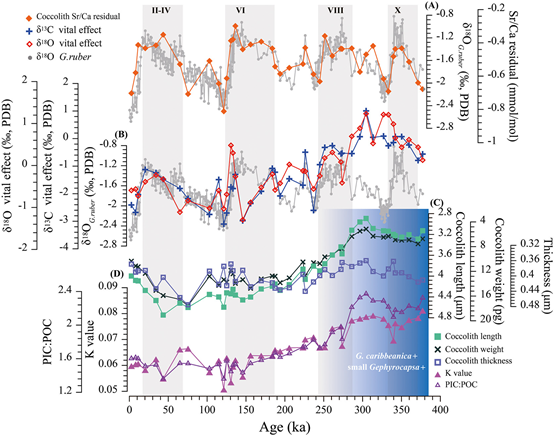Xiaobo Jin1, Chuanlian Liu1 , Hongrui Zhang1, Chao Zhou1, Xiaoying Jiang1, Zhouyang Wu1, Juan Xu1
1. State Key Laboratory of Marine Geology, Tongji University, Shanghai China.
Abstract:Coccolithophores play important roles in marine biochemistry due to the processes of calcification and photosynthesis. Coccoliths are produced intracellularly, and cells produce coccoliths with stable isotopes distinct from theoretically precipitated inorganic calcite due to the influences of coccolithophore physiology, which are the so-called vital effects. The coccolith isotopic vital effects show large variations between species and hamper the use of coccolith isotopes in paleoceanography. In addition, learning the coccolith isotopic vital effects can help to better understand the carbon fractionation in coccolithophore cell, so as to provide a new insight in reconstructing sea water carbonate system (e.g., from alkenone δ13C or directly from coccolith δ13C) in geological past. In the present study, we investigated the morphological parameters, growth rate, and coccolith stable isotope compositions of Gephyrocapsa, the most universal alkenone-producing coccolithophore across the Pleistocene. These data allow us to estimate the influences of Gephyrocapsa morphology as well as the growth rate on coccolith vital effects. The results showed that Gephyrocapsa morphology, as well as coccolith isotopes, varied with species and morphotype changes, which were evolutionarily forced over the past 400 ka. The small Gephyrocaps amorphotypes (G.caribbeanica and Gephyrocapsa <3 μm) produced more robust coccoliths with relatively heavier isotopes for both carbon and oxygen than that of the larger-sized G. oceanica. The carbon and oxygen vital effects were significantly correlated and showed negative values, suggesting a kinetic effect on bicarbonate formation during calcification. The Gephyrocapsa growth rate showed a glacial–interglacial cyclicality, and had close relations with coccolith isotopic vital effects before MIS 8 when G. oceanica dominated. It is suggested that coccolith isotopic fractionation were influenced by coccolithophore growth rate, however these effects were superimposed on an evolutionary forced coccolithophore (coccolith) size changes.

Full article:https://doi.org/10.1016/j.epsl.2018.09.010


